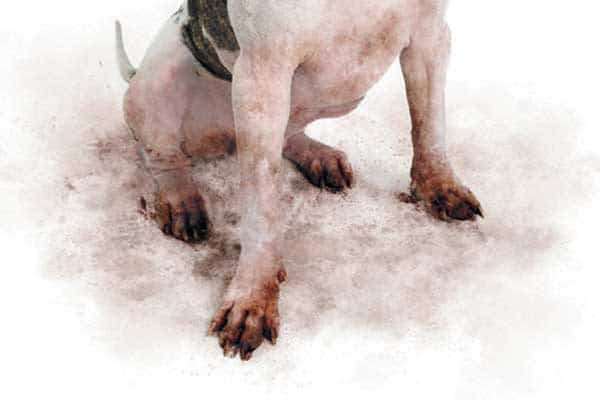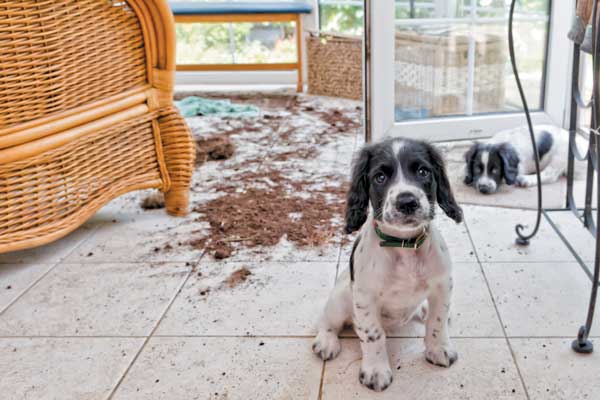If you live with a dog, you can expect muddy paws and pee to happen. But don’t worry. I’m here to help you take the EEE! out of cleaning.
Dealing with muddy paws

Here are some tips we can all use to help combat dirty and muddy paw prints. First, cut back on dirty paws by stopping your pup from digging in the yard and fencing off any areas that can get muddy, like flower beds. Next, make a wash station inside the door of your entry area.
Keep a big, washable rug and a basket of dog towels there. For wet days, you may want to add a hair dryer. Keep wipes in the car. Cleaning paws in the car not only makes getting into the house easier, but it also helps keep your car clean.
Right away, condition your dog to foot touching, as not all pups like their feet touched. Until he’s familiar with getting wiped down, take it slow, and use lots of encouragement and treats. If you’ll be wiping your dog’s paws at least once a day, use a gentle soap.
Try dry shampoo or one that’s used for show dogs and safe to be used daily. Finish off with a paw conditioner or moisturizer. There is such a thing as a paw-cleaning mitt! This glove is usually covered with microfiber material that grabs onto the dirt or mud, and is easy to wash. Simple microfiber cloths work, too.
Other ways to protect those paws and your floors
The right “shoes” can help keep your pup from bringing in dirt and mud. Choose booties meant for the type of outdoor activity your pup is doing, and take it slow at first. Use positive reinforcement to make it a good experience. Put natural dog wax products on your pup’s paws before you head outside. The wax barrier will help keep dirt and mud from getting too deep into the fur and sides of the paw pads.
Be careful of salt/sand. Material like salt or sand that is used on snow can be trouble. Wipe all this off your dog’s paws as soon as possible. Not only will it keep your dog from ingesting it when he licks his feet, it also keeps that abrasive material off your floors.
Pee in the house

There are four main reasons why a dog may be tinkling in places he shouldn’t: One — your pup isn’t housetrained yet or two — your dog is dealing with anxiety. (Turn to a professional trainer or behaviorist for the most effective way to solve this problem.) Three — Your dog is marking. More likely than not, you’ll have to deal with marking at some point in your dog-owning life.
As a dog sitter, I can’t tell you how many times a dog and his owner would come in for a meet and greet, and the pup would make a beeline to a piece of furniture and pee on it. “He never does that!” the pup’s parents will exclaim. It very well may be the first (or one of the few times) their pup has marked inside.
Imagine if you were that pup. You walk into a strange place, with all new things, everything smells like dog — EVERYTHING. What’s a pup to do? Claim a piece of the pie, that’s what! Four — Your dog is sick or a senior. If your dog suddenly starts to have accidents in the house, check in with your vet.
What to do when pee happens
Get to the pee when it’s wet.
- The faster you clean up an accident, the less likely you’ll get stuck with lingering smells.
- Place paper towels, newspaper or an absorbent chamois on top of and under (if possible) the messed area. Blot, don’t rub, until all the moisture is removed.
- Blot that same area with clean water.
Waited too late and now it’s dry?
- Don’t use a steam cleaner. You’ll want to, thinking it will make things better. It won’t. The heat will reactivate the smell and make things worse. Use a wet-vac on these spots instead.
- Utilize a pet odor neutralizer, or try the natural solution of covering the area in baking soda overnight and blotting with a vinegar/water solution in the morning.
- Use hydrogen peroxide to help with stubborn areas, but spot test an area of your flooring or furniture first to make sure the bleaching properties in the liquid won’t be a problem.
- When all else fails, call out the professionals. Carpet cleaners will often charge more for areas that are pee stained, but it’s worth it!
Thumbnail: Photography ©dageldog | Getty Images.
Editor’s note: This article appeared in Puppies, a special issue from Dogster magazine. Look for Puppies on a newsstand near you!
About the author
Wendy Newell is a former VP of Sales turned dog sitter, which keeps her busy being a dog chauffeur, picking up poop and sacrificing her bed. Wendy and her dog, Riggins, take their always-changing pack of pups on adventures throughout the Los Angeles area. Learn more about them on Facebook at The Active Pack and on Instagram at @wnewell.





